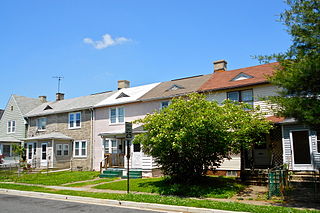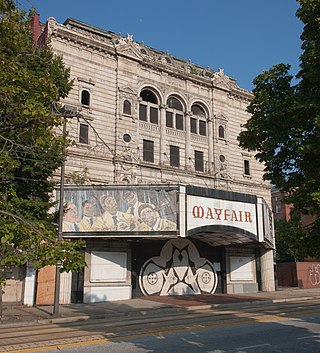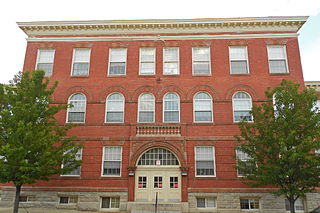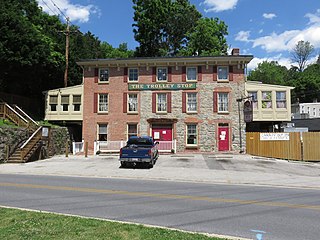
Locust Point is a peninsular neighborhood in Baltimore, Maryland. Located in South Baltimore, the neighborhood is entirely surrounded by the Locust Point Industrial Area; the traditional boundaries are Lawrence street to the west and the Patapsco River to the north, south, and east. It once served as a center of Baltimore's Polish-American, Irish-American and Italian-American communities; in more recent years Locust Point has seen gradual gentrification with the rehabilitation of Tide Point and Silo Point. The neighborhood is also noted as being the home of Fort McHenry and the western end of its namesake tunnel that carries eight lanes of Interstate 95 under the river.

The Western Maryland Railway was an American Class I railroad (1852–1983) that operated in Maryland, West Virginia, and Pennsylvania. It was primarily a coal hauling and freight railroad, with a small passenger train operation.

Mount Clare, also known as Mount Clare Mansion and generally known today as the Mount Clare Museum House, is the oldest Colonial-era structure in the City of Baltimore, Maryland, U.S.A. The Georgian style of architecture plantation house exhibits a somewhat altered five-part plan. It was built on a Carroll family plantation beginning in 1763 by barrister Charles Carroll the Barrister, (1723–1783), a descendant of the last Gaelic Lords of Éile in Ireland and a distant relative of the much better-known Charles Carroll of Carrollton, (1737–1832), longest living signer of the Declaration of Independence and the richest man in America in his later years, also the layer of the First Stone of the new Baltimore and Ohio Railroad, just a short distance away in 1828.

Silo Point, formerly known as the Baltimore and Ohio Locust Point Grain Terminal Elevator, is a residential complex converted from a high-rise grain elevator on the edge of the Locust Point neighborhood in Baltimore, Maryland. When the original grain elevator was completed in 1923, it was the largest and fastest in the world. The grain elevator rises to 300 feet. The silo was built by the Baltimore and Ohio Railroad in 1923–1924, with a capacity of 3.8 million bushels. In 2009 it had been converted from a grain elevator to a condominium tower containing 24 floors and 228 condominiums by Turner Development Group and architect Parameter, Inc.

The Avondale Mill was a large gable-front stone structure, three stories in height, and 10 bays long by three wide. It was located on the bank of the Patuxent River in the city of Laurel, Prince George's County, Maryland. It was constructed in 1844-1845 for Captain William Mason & Son of Baltimore. It was complemented by the neighboring Laurel Mill built in 1811 S.D. Heath's machine shop and Richard Israel's flouring mill. At that time it was provided with the machinery for the manufacture of fine cloth, running as many as 1,500 cotton spindles with 150 employees. In 1845, industrialist Peter Gorman was responsible for the first macadamized (paved) road in Laurel, Avondale Street next to the new Mill.

The Owings Upper Mill is a historic grist mill located at Owings Mills, Baltimore County, Maryland, United States. It is a large 3+1⁄2-story brick structure, 50 by 60 feet. The building stands on a low stone foundation, surmounted by a molded brick water table. Two frame extensions were built sometime in the 1880s. The words "EUREKA FLOUR MILL" are worked into the façade in purple brick between the second- and third-story windows. The building is probably the oldest and largest mill surviving in Baltimore County and was the last known project of Samuel Owings, the American Revolutionary War patriot and enterprising merchant.

Building at 423 West Baltimore Street is a historic retail and wholesale building located at Baltimore, Maryland, United States. It is a five-story loft structure of the Queen Anne style. It achieved its present configuration in 1893, as the result of extensive alteration of an existing three-story brick warehouse. The storefront retains its important cast-iron elements, and the upper floors are essentially unchanged.

The Chamber of Commerce Building is a historic office building located at Baltimore, Maryland, United States. It is a Renaissance Revival-style of architecture with a brown glazed brick building five floors in height, eleven bays long on the west/east sides, facing Commerce Street on the west and Custom House Avenue to the east. Three bays wide (north/south) on the Water Street side, and rebuilt 1904–1905, using still standing walls / facades. It was built during the rebuilding of the old financial district in Downtown Baltimore following the Great Baltimore Fire of Sunday/Monday, February 7–8, 1904 and features many terra cotta decorative elements. The rebuilt structure was designed by well-known Baltimore architect Charles E. Cassell. The original pre-fire building was designed by locally famous and prominent architect John Rudolph Niernsee in 1880 and was used by the old Corn and Flour Exchange, which maintained a trading floor on the fifth level.

Coca-Cola Baltimore Branch Factory is a historic factory complex located at Baltimore, Maryland, United States. It was constructed from 1921 to 1948 and built principally to house Coca-Cola's syrup-making operations. The complex is spread over a 9.4-acre (38,000 m2) site and includes a two-story brick syrup factory/sugar warehouse and an earlier two-story brick mattress factory that Coca-Cola acquired and adapted in the 1930s. Completed in 1948, the complex housed syrup-making operations as well as the Coca-Cola Company's chemistry department.

National Enameling and Stamping Company is a historic factory complex located at Baltimore, Maryland, United States. It was constructed in 1887 to serve as the works of the Baltimore branch of the nation's largest tinware manufacturer, the National Enameling and Stamping Company (NESCO). The densely packed complex fills an almost 5-acre (2.0 ha) site and consists of 17 interconnected buildings and one structure that vary in height from one to five stories. The complex was organized to house three primary functions in discrete sections: the manufacture of tinware, the manufacture of enameled and japanned wares, and storage, warehousing, and distribution. The plant ceased production of tinware and enameled wares in 1952.
Procter and Gamble Baltimore Plant is a historic factory complex located at Locust Point in Baltimore, Maryland, United States. It is a compact industrial complex built by the national corporation Procter & Gamble comprising five major three-story brick buildings spread over 10 acres (40,000 m2). These major buildings are the Process Building (1929), the Soap Chip Building (1929), the Bar Soap Building (1929), the Warehouse (1929), and the Tide Building (1949).

Rombro Building is a historic loft building located at Baltimore, Maryland, United States. It is a six-story loft building constructed in 1881, and designed as a double warehouse. The first floor storefronts feature brick, stone, terra cotta, and cast iron framing and reflects the Queen Anne style in its facade organization and detailing.

Montgomery Ward Warehouse and Retail Store is a historic warehouse and retail building in Baltimore, Maryland, United States. It is an eight-story concrete structure and is roughly shaped like a squared-off number "4". The front features a penthouse tower at the main entrance bay with a balcony and capped by a flagpole. The building houses over 1,200,000 square feet (110,000 m2) of floor space flooded by light from approximately 1,000 large multi-paned, steel frame windows. It was built about 1925 as a mail order and retail warehouse for Montgomery Ward on an 11 acres (4.5 ha) site adjacent to the Baltimore and Ohio Railroad tracks. The complex was one of nine large warehouses built by the company in the United States.

South Central Avenue Historic District is a national historic district in Baltimore, Maryland, United States. It contains brick two- and three-story industrial and residential buildings reflecting over 150 years of utilitarian adaptation of buildings and space. The district includes early 19th century rowhouses, late 19th century and early 20th century manufacturing and warehouse buildings, gas stations, stables, car barns, commercial/residential buildings, and corner stores. Several larger buildings are the Bagby Furniture Company Building, the Strauss Malt House, and the Alameda School. Many rowhouses have been covered with formstone.

Dundalk Historic District is a national historic district in Baltimore, and Baltimore County, Maryland, United States. The district is a cohesive unit made up of residential, commercial, and institutional buildings with structures that generally date from 1910 to 1940. Major architectural styles represented include Period Revival and Art Deco/Streamline Moderne. The District includes 962 resources contribute to its significance. It includes the only two housing developments built by the United States Shipping Board Merchant Fleet Corporation (EFC) in Maryland during World War I and reflects experimentation with Garden City planning ideals. Many of the buildings within the District represent the work of noted Baltimore architect Edward L. Palmer, Jr.

Market Center is a national historic district in Baltimore, Maryland, United States. It is an approximately 24-block area in downtown Baltimore that includes buildings associated with the development of the area as Baltimore's historic retail district. The area evolved from an early 19th-century neighborhood of urban rowhouses to a premiere shopping district featuring large department stores, grand theaters, and major chain stores. The diverse size, style, scale, and types of structures within the district reflect its residential origins and evolution as a downtown retail center.

Franklin Square Historic District is a national historic district in Baltimore, Maryland, United States. It is a 19th-century rowhouse neighborhood developed along a strict grid street pattern. A one square block, two and a half acre public park, Franklin Square, is a focal point for the area and the most elaborate rowhousing surrounds the square. The district contains approximately 1,300 buildings of which approximately 1,250 contribute to the significance of the historic district.

Baltimore East/South Clifton Park Historic District is a national historic district in Baltimore, Maryland, United States. It is primarily an urban residential area organized in a gridiron pattern. It comprises approximately 110 whole and partial blocks that formed the historic northeast corner of the City of Baltimore prior to 1888. While rowhouses dominate the urban area, the historic district also contains other property types which contribute to its character including brewing, meat packing, cigar manufacturing, printing, and a tobacco warehouse. The Baltimore Cemetery completes the historic district.

Ellicott's Mills Historic District is a national historic district at Oella, Baltimore County, Maryland, United States. It is on the east bank of the Patapsco River, opposite Ellicott City. This historic district designation relates to the industrial operations of the Ellicott family from the 1770s through the mid-19th century. It consists of the sites of historic buildings including: an 18th-century building, a section of an 18th-century mill incorporated in a 20th-century factory, a 19th-century tavern, 19th-century workers housing, and an 1859 Italianate villa built by John Ellicott. Historically, these industrious mills were served by the major east–west route in Maryland during the early 19th century, the old National Pike. Also in the district is the mammoth multi-story Wilkins-Rogers Company flour plant, which is located on the site of the 1792 Ellicott Flour Mill, the first merchant flour mill in the United States.

The Southern Terminal, Susquehanna and Tidewater Canal is a national historic district at Havre de Grace, Harford County, Maryland, United States. Located along the western bank of the Susquehanna River near its mouth at the Chesapeake Bay, it includes the Lock Master's House, the canal's outlet lock, and the foundations of a bulkhead wharf along the river side of the lock. Most of the structures built to serve aspects of the Susquehanna and Tidewater Canal operations are no longer standing, but the locations of warehouses, stables, and several other buildings, including a broom factory, are shown on old city maps.
























